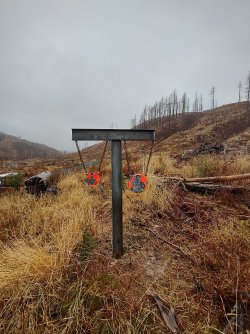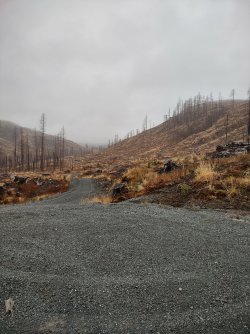2600' of trench for 8" gas main, now under the new soccer stadium in downtown STL.
Had to tie in to 12" steel with a bottom outlet.
Welders are always a pain in the ***. You can't just dig and shore a hole so they can safely weld and you can tap the main, you need to make them comfortable. You can see Ian back there laying down on the job.
When rain or ground water fills your trench overnight you gotta spend a few hours pumping it out. Thankfully I stacked the main ( basically dropped piles of 1" minus every 25 feet or so) so it wasn't floating when we got in the next day.


After digging the trench, in this case about 40" deep, fusing together 50' sticks of 8" and dropping them, hole gets backfilled with minus and tamped with a hydraulic tamper in 1" lifts. This was a major construction sight with excavators and earth movers the size of buildings rolling around so the trench had to be fairly deep and properly backfilled and tamped. The bad thing was that we already knew there was going to be a 4' fill in the middle 1000' of trench and another building, which would need a service, was going to be erected. That meant to dig this main up to install the service for that building eventually, someone was going to have to dig 7' down to get the main. Then shore the hole. Basically about 2 days of prep work to run a service that might take a couple hours to install. And sure enough about 11 months later I got a call from a guy tasked with running this service asking me how deep the main was.




The location of this new ballpark was partially where an onramp to highway 40 sat. Many, many years ago city blocks were leveled and 40' of fill was brought in to build the on ramp. When I first went to look at the job the site was still 40' taller than what it would be when I showed up to start digging a week and half later. That gives you an idea of how large these excavators were that they could move that much dirt that quickly. So at the grade I was digging I was pretty much trenching through foundations, old abandoned gas and water services and rubble that had been buried 40' deep for half a century or more. This meant 2 things. Since digging the trench was going to entail digging out all the type of hard rubble and metal fill that you cannot put plastic gas mains on, I was going to have to dig all that crap out. Meaning tracking back over my ditch was going to be impossible. So I had to make damn sure I had depth and a clean ditch before I moved down the line. It also meant that I was going to have to backfill it and tamp it in in 50 or 100 foot increments. I still managed to get about 350-400 feet a day. That's dug, pipe dropped and backfilled. 12 hour days, 6 days a week. Everything over 8 hours was time and a half and I got paid a premium for it being a haz mat area the entire time I was there. I did very well those 2 months. This job was very much a timed deal. In order for STL to be granted a franchise by MLS this stadium had to be done by a certain date. When I dug across 24th street, which is where the FBI building is located, I had some FBI guys come and yell at me for blocking their little short cut to the gas station. I told them in no uncertain terms that they could either drive around the block or eff off, either one worked for me. A bigshot at the company got a call from the FBI complaining about me. In the one thing since I started here that made me proud of the company, the FBI was told that if they wanted to explain to those billionaires why STL wouldn't be getting a soccer team that was on them, otherwise they could pound sand. I never heard from them FBI guys again.

A tie in hole in the making. My tie-ins incidentally are works of art.

I spent a few years digging holes like this too. These are holes over service tees which we abandon when they slate a building for demolition, which in north St. Louis there is endless work of that nature. This was after abandoning the services to two houses and backfilling with the rubble. A paving crew will come along later and dig out the tops and fill it with 12" of concrete.
Here are 6 holes I dug at my house. They are 48" deep, belled out like an elephant foot at the bottom, big enough for 10" sonotube. Which I dug by hand. Then hand mixed 87 bags ( 80LBS) of concrete. Set my beams and set my building well up above the highest known flood level. This is currently my humble little shop.
Anyway, even though the majority of these are pictures of holes I dug in an excavator, a huge part of my job involves hand digging through rubble. I dig over gaslines and other utilities with an excavator every day and once I feel what I am looking for with my bucket it's time to jump out and grab a shovel.























